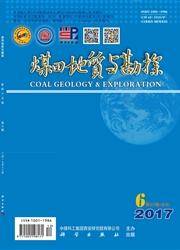

 中文摘要:
中文摘要:
运用层序地层原理,通过岩心和测井资料的综合分析,对新疆准东煤田西黑山勘查区西山窑组进行了层序地层研究,识别出3个体系域—)—低位、湖扩和高位体系域,并进一步进行了高频层序单元的划分。在层序地层格架的约束下,分析了西山窑组沉积体系的配置关系,识别出辫状河三角洲和湖泊沉积体系,进而细分为4个亚相和8个微相类型。同时,对煤岩样品进行了煤质分析和显微组分定量统计,确定了研究区煤相类型主要为潮湿森林沼泽相和干燥森林沼泽相。该区煤相的垂向演化规律受湖平面升降变化所控制,而湖平面的升降受层序地层格架的约束,在不同体系域中湖平面的变化控制泥炭沼泽的发育,从而决定了煤质煤相的演化规律。
 英文摘要:
英文摘要:
Based on the principle of sequence stratigraphy, the stratigraphic division of Xishanyao Formation in Xiheishan area is studied through the comprehensive analysis of the bore core and well logging data. As a result, such three system tracts as low-stand system tract, lake expanding system tract and high-stand system tract are recognized. Meanwhile, more para-stratigraphic sets are identified in each system tract. Therefore, braided river delta and lake depositional systems of Xishanyao Formation are deciphered into four subfacies and 8 microfacies under the constraint of sequence stratigraphic framework. Besides, coal quality and quantitative statistics of maceral are introduced in this study in order to identify the coal facies as moist forest swamp and dry forest swamp. The coal facies evolution law is controlled by the variation of lake level which was constrained under the frame- work of sequence stratigraphy in this area. As a main factor, the lake level determines the development of peat swamp, and then the evolution law of coal facies.
 同期刊论文项目
同期刊论文项目
 同项目期刊论文
同项目期刊论文
 Rare earth element geochemistry and fractionation in Jurassic coal from Dongsheng-Shenmu area, Ordos
Rare earth element geochemistry and fractionation in Jurassic coal from Dongsheng-Shenmu area, Ordos Well pattern optimization for Tectonic Coal Gas Drainage within Mining Subsidence Area at Xin'an Coa
Well pattern optimization for Tectonic Coal Gas Drainage within Mining Subsidence Area at Xin'an Coa Geochemistry and mineralogy of coal in the recently explored Zhundong large coal field in the Jungga
Geochemistry and mineralogy of coal in the recently explored Zhundong large coal field in the Jungga 期刊信息
期刊信息
